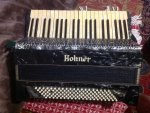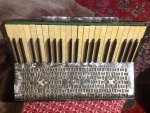Hi folks,
First time on here. I picked up a Hohner accordion at the weekend. It was just bought from a local antiques fair as a bit of fun!
I would like to learn as much as I can about it if possible but I cannot see a model name or number. Some paperwork it came with suggests it could be a Verdi IV but the views of members here would be appreciated.
Hopefully a couple of pictures attached!
Many thanks!
Jake
Technical problems, hopefully resolved now!


First time on here. I picked up a Hohner accordion at the weekend. It was just bought from a local antiques fair as a bit of fun!
I would like to learn as much as I can about it if possible but I cannot see a model name or number. Some paperwork it came with suggests it could be a Verdi IV but the views of members here would be appreciated.
Hopefully a couple of pictures attached!
Many thanks!
Jake
Technical problems, hopefully resolved now!


